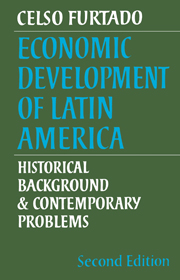Book contents
- Frontmatter
- Contents
- Tables
- Preface to the second edition
- Preface to the first edition
- Abbreviations
- Maps
- PART ONE FROM THE CONQUEST TO THE FORMATION OF NATION-STATES
- PART TWO ENTRY INTO THE SYSTEM OF INTERNATIONAL DIVISION OF LABOUR
- PART THREE THE TRADITIONAL STRUCTURAL PATTERN
- PART FOUR CHARACTERISTICS OF THE INDUSTRIALISATION PROCESS
- 10 The industrialisation process. i: The initial phase
- 11 The industrialisation process 2: Import substitution
- 12 Imbalances created by import-substituting industrialisation: structural inflation
- PART FIVE REORIENTATION OF DEVELOPMENT IN THE RECENT PERIOD
- PART SIX INTERNATIONAL RELATIONS
- PART SEVEN INTRA-REGIONAL RELATIONS
- PART EIGHT STRUCTURAL RECONSTRUCTION POLICIES
- Bibliography
- Index
11 - The industrialisation process 2: Import substitution
Published online by Cambridge University Press: 25 January 2010
- Frontmatter
- Contents
- Tables
- Preface to the second edition
- Preface to the first edition
- Abbreviations
- Maps
- PART ONE FROM THE CONQUEST TO THE FORMATION OF NATION-STATES
- PART TWO ENTRY INTO THE SYSTEM OF INTERNATIONAL DIVISION OF LABOUR
- PART THREE THE TRADITIONAL STRUCTURAL PATTERN
- PART FOUR CHARACTERISTICS OF THE INDUSTRIALISATION PROCESS
- 10 The industrialisation process. i: The initial phase
- 11 The industrialisation process 2: Import substitution
- 12 Imbalances created by import-substituting industrialisation: structural inflation
- PART FIVE REORIENTATION OF DEVELOPMENT IN THE RECENT PERIOD
- PART SIX INTERNATIONAL RELATIONS
- PART SEVEN INTRA-REGIONAL RELATIONS
- PART EIGHT STRUCTURAL RECONSTRUCTION POLICIES
- Bibliography
- Index
Summary
Intrinsic limitations of the first phase of industrialisation
The industrialisation process that had started in some Latin American countries was profoundly affected by the 1929 crisis. This does not mean that the crisis represents a watershed between a period of prosperity and a period of depression. Indeed, some countries had already shown symptoms of a decline in the export sector in the period immediately preceding the crisis. In Brazil, for instance, there had been recurrent crises of overproduction in coffee since before the First World War, and rubber had lost its privileged position in world trade in the 1920s. In Chile, the nitrate crisis sparked off by competition from the synthetic product had been a burden on the country's economy for more than a decade. Nonetheless, with the exception of Brazil, in all the region's most economically significant countries the quantum of exports was 50 to 100 per cent higher in the 1925-9 period than in the first decade of the century. It was in relation to the nature of the industrialisation process that the 1929 crisis constituted a landmark. Until then, the development of the industrial sector had been a reflexion of export expansion; from then on, industrialisation was induced largely through the structural tensions provoked by the decline or inadequate growth of the export sector. The exception to this rule is represented by countries that were to experience a phase of vigorous export growth in a later period: Venezuela, Peru and the Central American countries.
- Type
- Chapter
- Information
- Economic Development of Latin AmericaHistorical Background and Contemporary Problems, pp. 107 - 117Publisher: Cambridge University PressPrint publication year: 1977



